
Výzkum
Experimentální práce v jaderné fyzice je často rozmanitá, každý experiment je nějak unikátní, jsou použity různé detektory, různé měřící systémy a potkávají se noví lidé.
V této sekci naleznete výbět nejzajímavějších výsledků z poslední doby a to jak výsledků z mezinárodních spoluprácí, výsledků získaných v mezinárodních laboratořích, tak i výsledků z našeho vlastního experimentálního zázemí, zejména starého dobrého cyklotronu U120M.
Astrofyzikální reakce 17O(n, α)14C a aplikace metody ANC na přenos nukleonu 17O(d, p) při nízkých energiích.
Spolupracující subjekt: INFN-LNS ad.
AGB hvězdy - rudí obři v pokročilém stadiu vývoje - jsou původci mnoha prvků těžších než železo. Jejich produkce závisí na hustotě neutronů ve hvězdě. Jedna z reakcí, která by měla významně odčerpávat neutrony je 17O(n,α)14C. V práci byly studovány 4 stavy/rezonance v 18O, které jsou klíčem k této otázce. Kombinovaný přístup metodami THM a ANC dovoluje zpřesnit reakční rychlosti a ukazuje, že některé těžké izotopy (87Rb, 142Ce, 204Hg ad.) jsou produkovány o 10% - 20% častěji, než se doposud očekávalo.

Obr.: Rychlosti reakce 17O(n,α)14C v závislosti na teplotě (v miliardách Kelvinů). Zeleně je současný výsledek metodou ANC, černě a červeně dřívější předpoklady, modře - výsledek metodou THM.
[1] G. L. Guardo et al., “Asymptotic Normalization Coefficient Investigation of the 17O(d, p) Transfer for Astrophysical Application to the 17O(n, α)14C Reaction at Low Energies,” ApJ, vol. 975, no. 1, p. 32, Oct. 2024, doi: 10.3847/1538-4357/ad7604.
Hledání izotopu sodíku 22Na v Novách a nová metoda měření poločasů na úrovni femtosekund
Klasické novy jsou způsobeny termonukleárními explozemi v asymetrických dvojhvězdných systémech, kde hvězda předává hmotu bílému trpaslíkovi. Novy produkují radioaktivní izotopy 26Al a 22Na - jejich gama záření lze pozorovat z oběžné dráhy. Zatímco gama záření z rozpadu 26Al je k nám přichází ze všech míst Galaxie, 22Na zůstává nevystopovatelné. Důvodem je jednak krátký poločas rozpadu (2,6 roku), ale také neznáme, jaké množství 22Na nova vyrobí. Přesnější měření dovolí předpovědět možnosti budoucích orbitálních teleskopů takové pozorování učinit. Reakce 22Na(p, γ)23Mg zůstává jediným zdrojem velké nejistoty ohledně množství vyvrženého 22Na. Rychlost reakce je ovlivněna jedinou rezonancí (krátkožijícím stavem) při 7785 keV v 23Mg. V tomto experimentu byl použit svazek 24Mg na terči obsahující 3He a studován byl vznik právě 23Mg. Analýzou rychlostí 23Mg v momentu jeho vzniku a jeho rychlosti v momentu vyzáření gama (z krátkožijící rezonance) byly nalezeny doby života třech rezonancí v oblati 4 - 40 femtosekund. Tato nová, až přelomová metoda dovolila odhadnout, že u příští generace orbitálních gama detektorů bude maximální vzdálenost pro detekci 22Na z nov 10-12 tisíc světelných let (velikost naší galaxie je asi 100 tisíc světelných let).
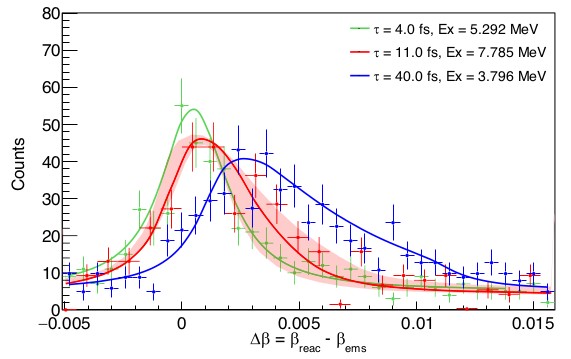
Obr.: Grafy ukazují rozdíly rychlosti iontu 23Mg v bodě reakce a v bodě emise gama. Proložené křivky ilustrují schopnost nové metody, kde u tří rezonancí lze rekonstruovat měřená data při dobách života 4, 11 a 40 fs.
[1] C. Fougères et al., “Search for 22Na in novae supported by a novel method for measuring femtosecond nuclear lifetimes,” Nat Commun, vol. 14, no. 1, p. 4536, Sep. 2023, doi: 10.1038/s41467-023-40121-3.
Nově pozorované rozpady pomocí dvou protonů v nestabilním fluoru/Nové úzké rezonance v nestabilním fluoru 15F
Ve spolupráci s laboratoří GANIL/SPIRAL2 ve Franci byla studována nestabilní jádra 15F, která vznikala v reakci na terči z CH2 bombardováním urychlenými jádry radioaktivního 14O. Jádra 15F žijí typicky kolem jedné zeptosekundy, takže jejich vzbuzené stavy jsou stavy rezonančními a mají typicky vlasní šířku v řádu stovky keV. V experimentu byl pozorován stav 5/2- se šířkou 3 keV a stav 3/2- se šířkou 28 keV. Tyto úzké a tedy déle-žijící stavy jsou podle analýzy výsledkem toho, že se energeticky nacházejí v blízkosti kvantových systémů 13N(1/2-)+2p a 14O(1-)+1p, s jádry 13N a 14O v konfiguraci s negativní paritou. Tato blízkost má vliv na uvedené pozorované rezonanční stavy, konfigurace se promíchávají a částečně je blokován přirozený elastický kanál reakce 14O(0+)+p. Ve shodě s výpočty byl pozorován sekvenční rozpad těchto stavů pomocí dvou protonů, ovšem výpočty předpovídají existenci dalšího stavu s přímým dvouprotonovým rozpadem blízko nad pozorovanými stavy. Systematický výzkum takových stavů může přinést důležité poznatky pro astrofyzikální měření, neboť rychlosti řady astrofyzikálních reakcí jsou dedukovány pouze z reakcí na zrcadlových jádrech a podobná kolektivizace stavů může být významným faktorem.
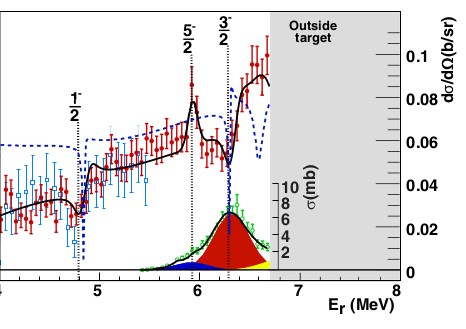
Obr.: Diferenciální účinný průřez reakce H(14O, p)14O (červené tečky a modré čtverečky) a celkový průřez reakce H(14O,2p)13N (zelené kroužky), obě jako funkce rekonstruované rezonanční energie Er v systému p+14O. Příspěvky 5/2−, 3/2− stavů a rezonancí s vyšší energií jsou zobrazeny modře, červeně a zeleně. Proložení R-matice dvou reakčních kanálů je znázorněno černou čarou. Modrá přerušovaná čára odpovídá výsledku výpočtu pomocí slupkového modelu GSMCC.
[1] V. Girard-Alcindor et al., “New narrow resonances observed in the unbound nucleus 15F,” Phys. Rev. C, vol. 105, no. 5, p. L051301, May 2022, doi: 10.1103/PhysRevC.105.L051301.
Získání informací o neutronovém spektru u urychlovačového zdroje založeného na deuteronech a berylliu
Vývoj nového rychlého neutronového zdroje založeného na cyklotronu a beryliovém cíli je studován na NPI CAS. Zdroj D(10)+Be vygeneroval neutronové energie pro dva rozdíly (14 mm a 154 mm) a skupiny Au, Co, Ti, In, Al, Fe, Ni, Nb byly ozařovány. Neutronový tok dosáhl 1,4x1010 cm-2s-1 na 14 mm a 4,1x108 cm-2s-1 na 154 mm. Zdroj nabízí aktivační analýzu, ověřování přechodových sekcí neutronů, simulace experimentálních reaktorů a zkoušky zradikalizovanosti materiálu.
[1] M. Stefanik, E. Simeckova, P. Bem, J. Stursa, V. Zach, and J. Mrazek, “Neutron spectrum determination of accelerator-driven d(10)+Be neutron source using the multi-foil activation technique,” Radiation Physics and Chemistry, vol. 190, p. 109767, Jan. 2022, doi: 10.1016/j.radphyschem.2021.109767.
Výzkum nukleosyntézy v AGB hvězdách metodou trojského koně
-
Spolupracující subjekt: INFN-LNS
Hvězdy AGB jsou klíčová astrofyzikální místa ovlivňující jadernou syntézu a chemické složení. K jaderné syntéze jsou potřebné výsledky experimentů, získané pomocí metody „Trojského koně“ a asymptotickou normalizační koeficient technikami nepřímo. Tato zpráva diskutuje experimentální postup a vyvozené rychlosti reakcí. Zároveň jsou zde uvedeny studie, které mají zájem o AGB jadernou syntézu.

Obr.: Poměr reakční rychlosti zjištěné v této práci k předchozím známým výsledkům. Zeleně je rozsah neurčitostí.
[1] M. L. Sergi et al., “Trojan Horse Investigation for AGB Stellar Nucleosynthesis,” Universe, vol. 8, no. 2, Art. no. 2, Feb. 2022, doi: 10.3390/universe8020128.
26Si(p,γ)27P protonový záchyt metodou ANC pro zrcadlová jádra
- Spolupracující subjekt: INFN-LNS
Radioaktivní izotop 26Al je za pomoci družic pozorován podél roviny Mléčné dráhy. Jeho původ je v posledních 40ti letech silně diskutován. Tento izotop vzniká z části také ve formě izomeru 26mAl, který je ovšem pro družice neviditelný. Na cyklotronu v ÚJF AVČR v Řeži jsme studovali reakci zachycení protonu v jádře 26Si. Pokud totiž toto jádro nezachytí proton, přemění se na 26mAl a ztratí se z pozorování. Naše informace přispívají ke zjištění skutečného množství 26Al v galaxii.
[1] G. D’Agata et al., “26Si(p, γ)27P direct proton capture by means of the asymptotic normalization coefficients method for mirror nuclei,” Phys. Rev. C, vol. 103, no. 1, p. 015806, Jan. 2021, doi: 10.1103/PhysRevC.103.015806.
Deuteronem indukované reakce na přírodním Zr do 60 MeV
Budoucí energetická zařízení založená na fúzi nebo štěpení potřebují spolehlivá data o aktivaci konstrukčních a terčových materiálů. Reakce vyvolané deuterony je obtížné teoreticky popsat, protože jsou kombinací řady různých procesů. Experimentálně jsme studovali aktivaci zirkonu na deuteronovém svazku cyklotronu U120-M ÚJF Řež, získali jsme nová data a vyjasnili dříve nepřehlednou situaci v produkci izotopů Niobu. Všechna dostupná data byla zahrnuta do komplexní analýzy a konzistentně popsána kombinací konkurenčních mechanismů reakce (break-up, přímý proces, složené jádro, …).
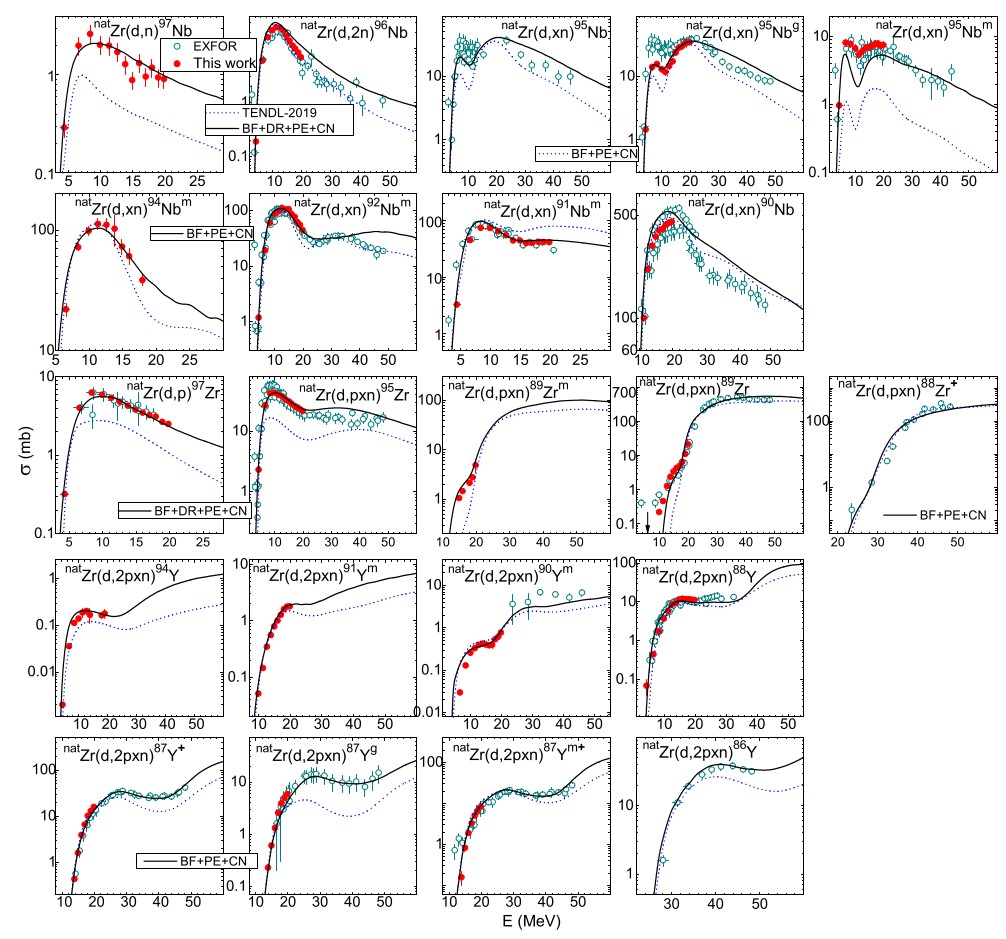
Obr.: Energetická závislost aktivačního průřezu deuteronem indukovaných reakcí na Zr. Červené body - naše měření, plné čáry - naše výpočty.
[1] E. Šimečková et al., “Deuteron-induced reactions on natZr up to 60 MeV,” Phys. Rev. C, vol. 104, no. 4, p. 044615, Oct. 2021, doi: 10.1103/PhysRevC.104.044615.
Zkoumání jaderných sil limity stability: případy 16F a 15F
- Spolupracující subjekt: GANIL/SPIRAL2
Jádra, která jsou vzdálena od stability, nám poskytují příležitost abychom lépe porozuměli vlastnostem jaderné hmoty. Izotopy fluoru 15F a 16F (bohaté na protony) nejsou vázané, téměř okamžitě po vzniku se rozpadají. Několik experimentů využívajících metodu rezonančního elastického rozptylu bylo provedeno v laboratoři GANIL pomocí radioaktivních svazků. Cílem bylo zjištění vlastnosti nízko položených stavů těchto jader. Byla pozorována silná asymetrie mezi zrcadlovými páry 16F-16N a 15F-15C. Asymetrii 16N-16N lze vysvětlit rozdíly v distribuci nukleonů. Ne tak ve druhém případě. Tam jsme získali indicie, že asymetrie by mohla být známkou nového efektu - např. neobvyklé vyšší vzájemné vazby dvou protonů v jádře 15F.
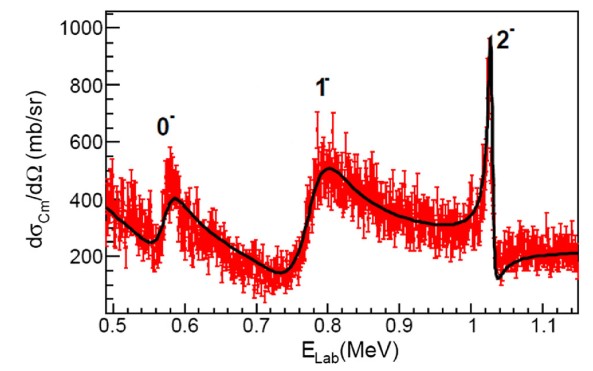
Obr.: Excitační funkce reakce 15O(p,p’) (z naší předchozí práce). Jasně jsou viditelné tři stavy (tzv. rezonance) v jádře 16F. Plná čára je teoretický popis.
[1] V. Girard-Alcindor et al., “Probing nuclear forces beyond the nuclear drip line: the cases of 16F and 15F,” Eur. Phys. J. A, vol. 57, no. 3, p. 93, Mar. 2021, doi: 10.1140/epja/s10050-021-00410-1.
Astrofyzikální S-faktor reakce 3He(α, γ)7Be získaný metodou ANC
- Spolupracující subjekt: ATOMKI, INFN-LNS
Detekce neutrin produkovaných ve slunci reakcemi pp a CNO cyklů může pomoci testovat standardní solární modely. Reakce 3He(α,γ)7Be je první reakcí ve dvou větvích pp cyklu a její účinný průřez ovlivňuje předpovědi pro 7Be a 8B toky neutrin. Znalost účinného průřezu s lepší přesností je proto nezbytná. V práci byla studována tato reakce technikou asymptotických normalizačních koeficientů ANC a astrofyzikální S-faktor byl změřen s požadovanou přesností.

Obr.: Souhrn posledních výsledků pro S-faktor reakce 3He(α,γ)7Be. Červená značka je současné měření, centrální linie ukazuje doporučenou hodnotu s neurčitostí, vyjádřenou šedým polem.
[1] G. G. Kiss et al., “Astrophysical S-factor for the 3He(α,γ)7Be reaction via the asymptotic normalization coefficient (ANC) method,” Physics Letters B, vol. 807, p. 135606, Aug. 2020, doi: 10.1016/j.physletb.2020.135606.
Reakce deuteronů na manganu při nízkých energiích
- Spolupracující subjekt: IFIN/HH
Chybějící systematická data a komplexita interakcí deuteronu vyžadují společné úsilí experimentátorů a teoretiků při měřeních aktivačních průřezů. Reakce indukované neutrony a protony, které následují breakup musí být rovněž vzaty v potaz. Deuteronové aktivační průřezy 54,56Mn a 51Cr na 55Mn byly změřeny při energiích okolo 20 MeV. Ukazuje se, že největší diskrepance v současných doporučených hodnotách jsou způsobovány nesprávným započítáním přímých procesů.

Obr.: Předešlá a současná data (červené body) a výpočty příspěvků jednotlivých procesů. Různé komponenty (PE, CN, DR, BU) jsou na obrázku vyznačeny.
[1] M. Avrigeanu et al., “Deuteron-induced reactions on manganese at low energies,” Phys. Rev. C, vol. 101, no. 2, p. 024605, Feb. 2020, doi: 10.1103/PhysRevC.101.024605.
Nepřímá měření průřezu reakce 3He(n, p)3H při energiích Big Bang nucleosyntézy.
- Spolupracující subjekt: INFN-LNS
Jaderné reakce hrají klíčovou roli při nukleosyntéze po Velkém třesku. Síť 12 základních reakcí určuje hlavní cestu, kterou se ubírá nukleosyntéza prvků a izotopů v prvních 20ti minutách historie vesmíru. V posledních dekádách bylo věnováno velké úsilí lepšímu porozumění roli reakcí s neutrony v nukleosyntéze Velkého třesku. V této práci byly pomocí nepřímé metody Trojského koně extrahovány účinné průřezy pro reakci 3He(n,p)3H v oblasti astrofyzikálních energií.
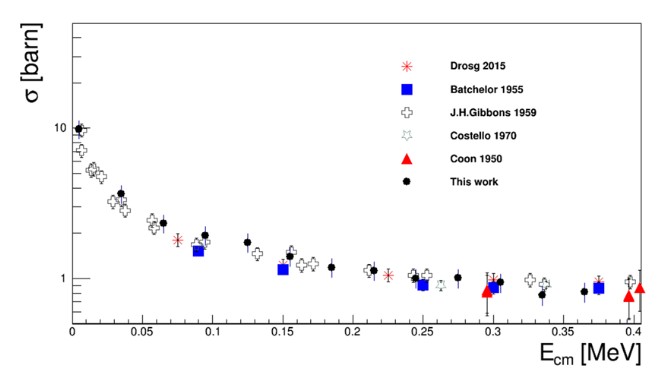
Obr.: Účinný průřez binární reakce 3He(n,p)3H (černé body) po započtení penetračního faktoru a normalizovaný na přímá data. Body byly extrahovány metodou THM a na obrázku jsou uvedeny pouze chyby statistické a vzniklé při normalizaci.
[1] R. G. Pizzone et al., “Indirect measurement of the 3He (n,p) 3H reaction cross section at Big Bang energies,” Eur. Phys. J. A, vol. 56, no. 8, p. 199, Aug. 2020, doi: 10.1140/epja/s10050-020-00212-x.
Měření účinného průřezu kosmologicky relevantní reakce 7Be(n,)4He
Krátce po Velkém Třesku dochází k syntéze nejlehčích jader. Současné modely nedávají uspokojivé vysvětlení pro pozorované zastoupení 7Li ve vesmíru. Experimentální studium se zaměřilo na reakci destrukce 7Be, které jinak transmutuje na 7Li, neutrony. Použita byla nepřímá metoda trojského koně, kdy namísto neutronů byly jádra 7Be sráženy s jádry těžkého vodíku, které obsahuje požadovaný neutron. Byly upřesněny informace o účinném průřezu v kosmologických energií.

Obr.: Umístění soustavy detektorů ve vakuové komoře EXOTIC v INFN-LNS.
[1] L. Lamia et al., “Cross-section Measurement of the Cosmologically Relevant 7Be(n, α)4He Reaction over a Broad Energy Range in a Single Experiment,” ApJ, vol. 879, no. 1, p. 23, Jun. 2019, doi: 10.3847/1538-4357/ab2234.
Studium vlastností jádra 34Si z rozpadu milisekundových izotopů 34Mg a 34Al
U jader v okolí 34Mg jsou narušena tradiční magická čísla – počty neutronů a protonů, které vykazují velkou míru stability izotopů. V regionu se objevují také neočekávané efekty současné existence více druhů deformací. Bylo významně rozšířena znalost schémata stavů 34Si (o 11 hladin a 26 gama přechodů), pozorování byla srovnána s nejpokročilejšími modely a byly vyvozeny závěry s směšování deformací. Nebyly nalezeny argumenty pro předpovídanou triaxiální deformaci.
IFIN-HH, Bucharest, ISOLDE CERN Physical Review C 100, 034306 (2019), 10.1103/PhysRevC.100.034306
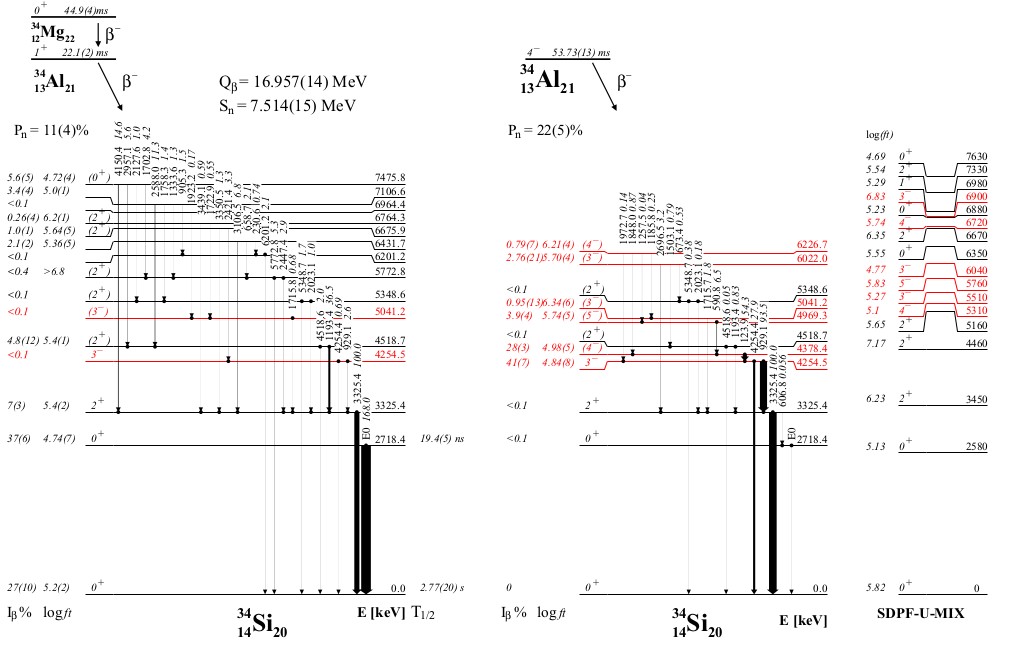
Obr.: Schéma vzbuzených stavů 34Si obohacené o 11 nových hladin a 26 přechodů a srovnání s předpovědí modelu SDPF-U-MIX. Červeně jsou označeny stavy se zápornou paritou.
[1] IDS Collaboration et al., “Normal and intruder configurations in 34Si populated in the β− decay of 34Mg and 34Al,” Phys. Rev. C, vol. 100, no. 3, p. 034306, Sep. 2019, doi: 10.1103/PhysRevC.100.034306.
Určení astrofyzikálního S-faktoru pro přímý radiační záchyt 18O(p,)19F metodou ANC
- Spolupráce: TA&MU, INFN LNS
V červených obrech – hvězdách typu AGB – je syntetizován izotop 19F z izotopu 18O. Většina kyslíku 18O je zničena v reakci 18O(p, )15N, avšak proces 18O(p,)19F může hrát podstatnou roli v určité fázi evoluce hvězdy. Nepřímou metodou ANC jsme na cyklotronu v ÚJF AVČR určili účinné průřezy přímé složky tohoto radiačního záchytu a výsledky porovnali se dvěma vzájemně si protiřečícími měřeními.
European Physical Journal A 55, 114 (2019), 10.1140/epja/i2019-12801-8
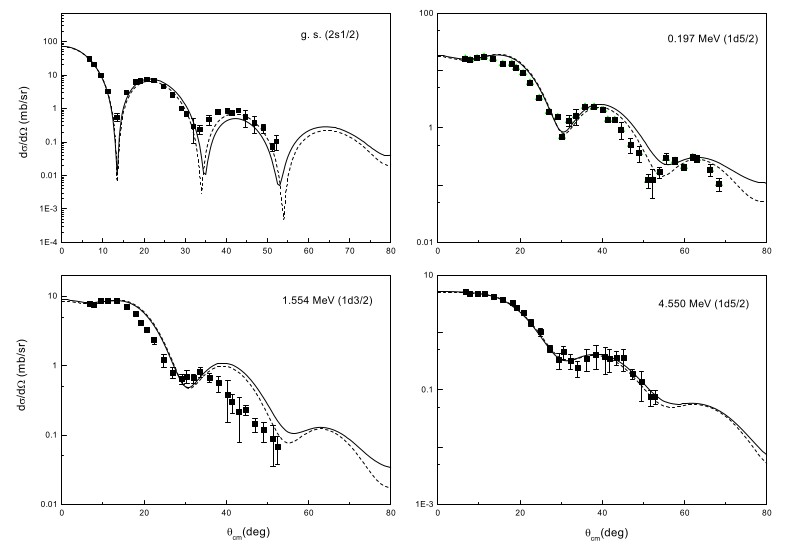
Obr.: Úhlové rozdělení deuteronů na čtyřech stavech 19F z reakce 18O(3He,d)19F, která byla použita pro dovození účinného průřezu záchytu protonu na 18O.
[1] V. Burjan et al., “The determination of the astrophysical S-factor of the direct 18O(p,γ)19F capture by the ANC method,” Eur. Phys. J. A, vol. 55, no. 7, p. 114, Jul. 2019, doi: 10.1140/epja/i2019-12801-8.
Konzistentní popis reakcí deuteronu na přírodní směsi Cr do energie 60 MeV
- Spolupracující subjekt: IFIN HH, Rumunsko
Reakční databáze používané v průmyslu a aplikovaném výzkumu jsou založeny zejména na výpočtech rovnovážných a předrovnovážných procesů. Experimentálně pozorované diskrepance v měřeních v ÚJF AVČR v centru CANAM u izotopů chromu byly popsány přímými procesy jako je break-up a stripping. Bylo ukázáno, že tyto procesy hrají roli v celém oboru energií a reakce deuteronu s jádry v okolí Coulombovské bariéry probíhají do velké míry přímými procesy.

Obr.: Totální účinné průřezy (plnou čarou) jsou u jednotlivých izotopů souhrnem řady procesů, které lze rozdělit na rovnovážné procesy (PE, CN) a přímé procesy (DR, BU). U nízkých (Coulombických) energií jsou přímé procesy (DR) kruciální.
[1] E. Šimečková et al., “Consistent account of deuteron-induced reactions on natCr up to 60 MeV,” Phys. Rev. C, vol. 98, no. 3, p. 034606, Sep. 2018, doi: 10.1103/PhysRevC.98.034606.
Intenzity gama záření z rozpadu izomeru zlata 196m2Au
Fólie zlata jsou používány pro svou čistotu jako monitorovací standard pro neutrony. Na generátorech rychlých neutronů v ÚJF AVČR v urychlovačovém centru CANAM byly ozařovány zlaté fólie. Vyprodukovány a měřeny byly izomery radioaktivního izotopu 196Au a zpřesněna (faktorem několik) byla řada intenzit pozorovaných gama přechodů, což potenciálně znamená významnou redukci nejistot v budoucích měřeních a aplikacích s neutrony.

Obr.: Změřené gama spektrum aktivovaného zlata.
[1] M. Majerle et al., “The intensities of γ-rays from the decay of 196m2Au,” Applied Radiation and Isotopes, vol. 141, pp. 5–9, Nov. 2018, doi: 10.1016/j.apradiso.2018.07.026.
Studium elastického a neelastického rozptylu 3He na 9Be při energiích 30-60MeV
- Spolupracující subjekt: JINR Dubna
Jádro 9Be je příkladem tzv. Borromeanského systému, kdy je jádro tvořeno třemi částmi (2x alfa a jeden neutron). V ÚJF AVČR, centru urychlovačů CANAM, jsme měřili účinné průřezy rozptylu 3He na 9Be. Experimentální výsledky byly analyzovány v rámci optického modelu, Wood-Saxon a folding potenciály, a metodou vázaných kanálů. Analýza ukázala, že excitovaný stav (5/2-) 9Be je silně deformovaný (beta=0.8).

Obr.: Popis experimentálních bodů úhlových rozdělení rozptylu pro stav 5/2- 9Be pomocí Woods-Saxon (WS) a double folding (DF) potenciálů.
[1] D. M. Janseitov et al., “Investigation of the elastic and inelastic scattering of 3He from 9Be in the energy range 30–60MeV,” Int. J. Mod. Phys. E, vol. 27, no. 10, p. 1850089, Oct. 2018, doi: 10.1142/S0218301318500891.

